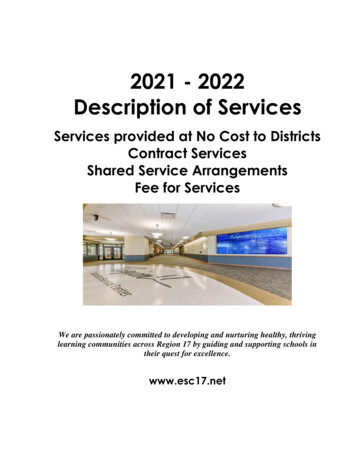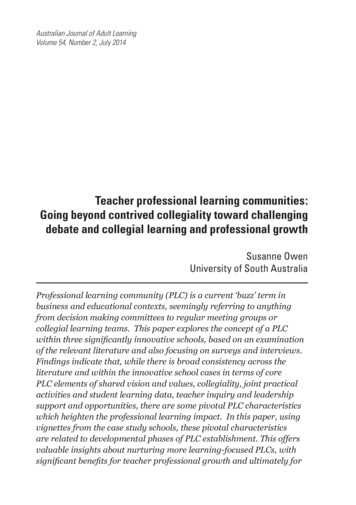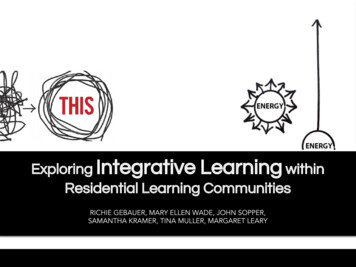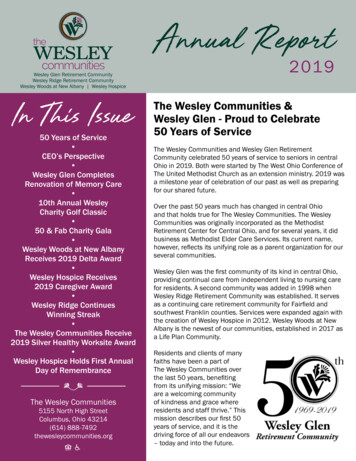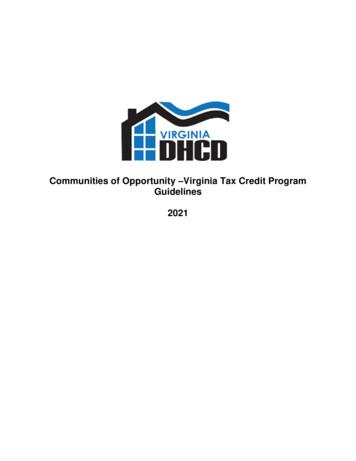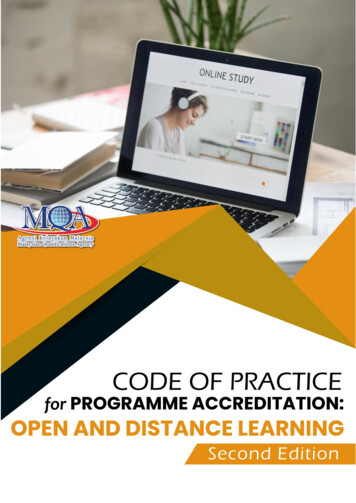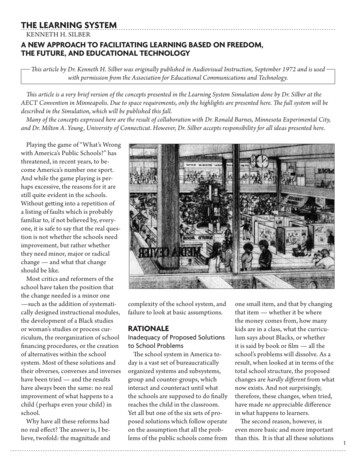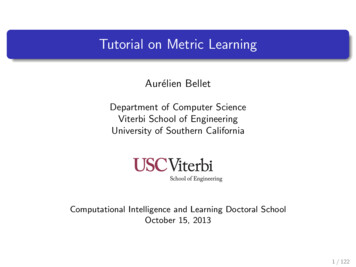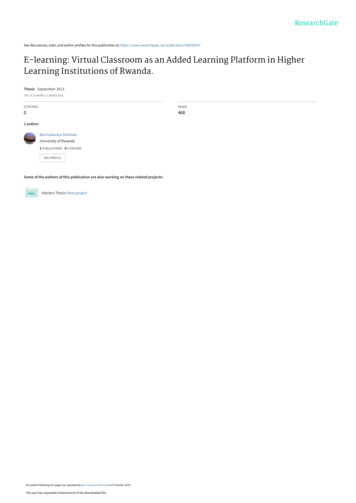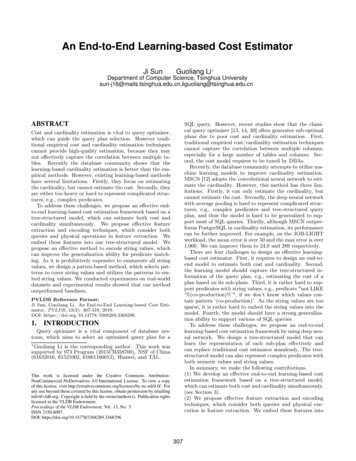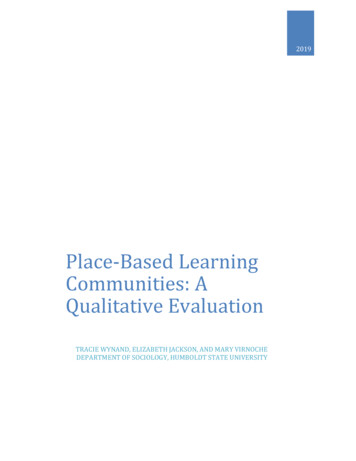
Transcription
2019Place-Based LearningCommunities: AQualitative EvaluationTRACIE WYNAND, ELIZABETH JACKSON, AND MARY VIRNOCHEDEPARTMENT OF SOCIOLOGY, HUMBOLDT STATE UNIVERSITY
Acknowledgements:Thank you to the students, staff, faculty, and campus departments that have contributed to thiswork. Thanks to the Office of Diversity, Equity and Inclusion as well as the Latinx Center forAcademic Excellence for their help in designing and implementing the focus groups. Thisproject would not have been possible without the support of Edelmira Reynoso, LaurenEnriquez, Steven Margell, Raven Palomera, Katlin Goldenberg, and Amy Sprowles fororganizing the work. Thanks to the team of graduate and undergraduate students who facilitatedthe Focus Group sessions and offered invaluable insight into the various themes that emerged.Thank you to the students who participated and offered their voices and recounted experiences.Thanks to Steven Margell for transcribing the audio files and to Matthew Johnson for commentson an earlier draft of this report. This work was funded by the Department of Education’sHispanic Serving Institution STEM grant.1
Place-Based Learning Communities: A Qualitative EvaluationIntroductionPlaced-Based Learning Communities (PBLC) foster student success, particularly instudent populations living away from their families for the first time. By co-enrolling a cohortof students in two or more classes and providing additional programming, learning communitiesfoster a connection among students and faculty. Sustained peer and faculty relationships supportsocial and academic belonging and related retention and academic success outcomes.In 2015, Science, Technology, Engineering, and Mathematics (STEM) major programsat Humboldt State University (HSU) launched their first PBLC: Klamath Connection. By fall2019, HSU offered four STEM PBLCs: Klamath Connection (Environmental ResourcesEngineering, Environmental Science & Management, Fisheries Biology, Forestry, and Wildlifemajors); Stars to Rocks (Chemistry, Geology, and Physics and Astronomy majors); RisingTides (Biology - Marine Biology concentration, and Oceanography majors); and Among Giants(Biology, Botany, and Zoology majors). Plans for a fifth PBLC for Math and Computer Sciencemajors, Representing Realities, will extend by fall 2020 the opportunity to every HSU incomingfirst-year STEM student.This evaluation is based on spring 2019 qualitative data from six small group interviewswith a total of 14 PBLC students. The data included broadly a story of building diverseinclusive communities. Within the community building theme, students discussed accounts ofmaking their way with academic friends, building trusted relationships with faculty and peermentors, and a range of experiences of racial and ethnic identity in relationship to the programorganization and communities. On the latter, students emphasized the importance of learning2
about area Indigenous communities. At the same time, students of color -- none of whomidentified as Indigenous -- did not recognize a valuing of their own ethnic and racial identities inthe program structure. Their accounts point to the PBLC outsourcing of ethnic and racialconnections to clubs and cultural centers. Finally, as building foundations for student initiativeand self-advocacy are important to the PBLC program, we discuss in the last analysis sectionaccounts related to this theme. While there were few accounts of agency, their inclusion in thisreport may provide insights for future exploration and consideration.MethodsThis evaluation is based on semistructured interviews with six small groups of studentswho participated in PBLCs during the 2018-19 academic year (Institutional Review Board # 18076). In Spring 2019, flyers were hung across the campus and the PBLC staff and facultyinvited via email all students (n 219) enrolled in the three PBLCs operating at the time toparticipate in group interviews related to their PBLC experience and incentivized participationby providing pizza. A semistructured interview guide (Appendix A) was developed incollaboration with the Office of Diversity, Equity and Inclusion (ODEI), the Office ofInstitutional Research, and PBLC staff. In addition to the questions, the guide included anopening script describing the interview purpose, and confirmation of participant anonymity.The program recruited and hired graduate students from the Departments of Sociology andPsychology and a staff person from ODEI to facilitate the discussions. The students were paidwith HSI STEM grant funds. The week prior to interviews, facilitators met with program staffto review the interview guide and processes.3
A total of 14 students (6% PBLC enrollment) participated in small groups of two tothree students (Table 1). Five groups exclusively included students from the PBLC KlamathConnection. One group included students from the PBLC Stars to Rocks. No studentsparticipated from Rising Tides. Three groups exclusively consisted of students of color. Twogroups exclusively included White students. One group included one Latino and one Whitestudent.Table 1: Small Group Interview DemographicsnPBLCRace/EthnicityGroup 13KlamathBlack (1) / Latino (1) / Asian & White (1)Group 22Stars to RocksLatino (1) / African-American & White (1)Group 33KlamathWhite (3)Group 42KlamathLatino (1) / White (1)Group 52KlamathLatino (1) / African-American & White (1)Group 62KlamathWhite (2)Facilitators captured digital recordings of the interviews that ranged in duration from 60to 90 minutes. Facilitators provided participants with a packet that included the interview guideand a survey. After describing the process and confidentiality, the facilitators asked participantsto take “a few minutes to gather your thoughts and write responses” to the interview questions.These were collected at the end of the interviews, along with an additional survey instrument.Most participants (12) submitted their packet. After the interviews, facilitators debriefed withprogram staff discussing common themes across interviews. The interviews explored questionsrelated to PBLC facilitation of peer connections and friendships, student attitudes about theprogram valuing their ethnic/racial identity, challenges that students faced before and during the4
program, as well as identification of resources provided by PBLCs that helped mitigatechallenges.Program staff hired two research assistants from the HSU graduate program inSociology to analyze interview transcriptions prepared by a professional service. Researchersimported the transcriptions into Atlas.ti Cloud to support analysis. Researchers drew onfacilitator debriefing notes to support development of initial codes. They expanded on thosecodes through close reading of interview transcripts. They each initially coded three transcriptsand then reviewed and validated coding of each other’s analysis. Graduate researchers met witha sociology faculty member to discuss initial coding and strategies for “coding” up to broaderthemes. The graduate students and the faculty member collaborated on the drafting and editingof this report.To provide a sense of the “thickness” of narrative themes, the findings below reportcounts of narrative “blocks.” A block represents a section of interview text ranging from oneline to several paragraphs. Because of the typical limits of group interviewing (narrative isattributed to a group – not to distinct individuals), the analysis should not be interpreted torepresent the extent to which a theme represents the accounts of any portion of totalparticipants. Instead, the analysis identifies only that a theme was discussed within a group –and typically because it was prompted by the interview guide (e.g. How do your friendshipscompare with the people who are in the PBLCs to those outside the PBLCs? How do you feelthat the PBLC experience has prepared you for connecting, working, and living in a diversecommunity . culturally, ethnically, economically ). Particularly because the groups weresmall, facilitators directed/prompted each participant to respond to a given question. Withingroups, there was consistency in experience signaled by responses such as “I agree” or by5
additional accounts or explanations by other group members that confirmed and expanded onthe experience of another participant in the group. The facilitators also synthesized the ideas thatthey had heard across group members and asked for clarification and confirmation. Therefore,we have confidence that a pattern or process identified within a given group can be attributed tothe overall experience of group members. If there was variation within a group or across groups,we identified that variation in our analysis. After initial analysis of audio recording transcripts,graduate research assistants compared packet notes made by individual students from a givengroup to the overall themes the facilitator confirmed as common to the group. In all cases, thethemes attributed to the group were consistent with the notes made by individual participantswithin a group.The analysis is limited by the small sample size of groups (6), as well as the group sizes(2-3). Nevertheless, as is often – though not always – the case, the goal of qualitativeinterviewing is to identify a range of experiences or processes and provide the reader with aportal into some level of nuance in the identified patterns. Ideally, the researcher(s) engage in aniterative process of data collection, analysis, and further theoretical sampling of additionalparticipants until analytical saturation is accomplished. The practicalities of this evaluationresearch did not move through that process; still, the report below provides a sense of at leastsome of the patterned experiences of a small sample of PBLC participants and possibledirections for further program planning and development.6
Building Diverse Inclusive CommunitiesOn a college campus, students engage in community building related to academic andsocial life. Both academic and social integration or belonging are positively related to collegestudent success. Academic belonging relates to connections with faculty members, majorcontent, and articulations of peers as an academic partners, resources, and collaborators. Socialbelonging relates to friendship connections to peers and campus community relationships, aswell as experiences of symbolic and interactional connection within and across space. Forexample, on the latter, posters announcing a queer film festival are not just instrumental inadvertising an event: poster images, narratives, and even placements across spaces producestrands of a larger symbolic canvas that makes (in)visible particular bodies, identities, andexperiences.In the HSU PBLCs, initiation of academic belonging begins during the SummerImmersion program. PBLC faculty and staff designed the Summer Immersion environment todeliver six program specific messages for cultivating academic belonging:1. You are welcome in this exciting and diverse place and this academiccommunity of learners;2. You are a beginning scientist, and scientific content at HSU begins immediately;3. The outdoors are part of your classroom;4. As you work together to solve complex social and environmental problems, youwill link knowledge from across disciplines;5. Your peers can help you learn, and vice versa; and6. You have a range of offices and people—faculty, staff, students—who are hereto support you and help you succeed.7
All groups of students discussed the importance of both peer and faculty relationships intheir new academic home. While academic belonging becomes more critical as a studentprogresses in their undergraduate education, building first year foundations for academicbelonging sets the stage for ongoing success.The PBLC programming also introduces students to the Indigenous landscape of theirnew campus home, as well as tools for living and working in inclusive and diversecommunities. In this analysis, we found most narratives related to diversity were woven intostudent experiences of academic and social life. Yet because of the importance of diversity andinclusion to the PBLC project, we present the creation of diversity as its own analytic category.This framework for analysis provides an analytic tool for highlighting positive experiences ofdiversity, as well as challenges related to this important program goal.In the following sections, we present our analysis of interview data related to theproduction of communities, both academic and social, across represented PBLC programs. Wehighlight three processes that produce those experiences of community: making their way withacademic friends, trusting faculty and peer mentors as expert guides, and talking about racialand ethnic identities.Making their Way with Academic FriendsMost narratives related to belonging highlighted the significance of academic friends inacademic and social community building. Narratives of academic belonging were more likely toreference academic peer relationships than those academic relationships with faculty, andacademic advisors. In most cases, PBLC students used friend and (academic) peerinterchangeably, suggesting the tight coupling of social and academic worlds. Two thirds of the8
117 narrative blocks about peer (classmate) connections overlapped with narratives offriendship.When prompted, “How did you make your closest friends,” students pointed to severalstructural components of the PBLC program that made it easier for them to forge thoserelationships. Summer Immersion, Themed Housing, Block Scheduling, and the First YearSeminar class (“Science 100”) all provided opportunities to make strong and lasting friendshipconnections with their cohort.In Klamath Group 5 with one Latino student and one White student, one PBLC studentemphasized the importance of the PBLC community to their ability to make friends:Because I feel like without Klamath, I wouldn't have made any friends. I'm justnot a very social person, in general. So I feel like sort of, not forcing, but justpushing us to hang out with the people in our group and sort of get to know eachother made it really easy for us to be friends and hang out. Especially since wedid have the same classes. We were kind of just like, "Oh hey, I remember youfrom Immersion. You want to sit next to me?" And kind of hung out like that.In Group 6 with two White Klamath Connection students, one student said:As far as my peers and friends, I feel like they are always super supportive .We're all in the same classes, and somebody might be done with an assignmentand I'll be like, "I really don't get this, can you help me?" They're just, it's moreconvenient to come to them first, because they're there in my dorm and we justgo to each other's rooms be like, "Yeah, come on, I'll hook you up.”They also felt they were able to make friends easier because they knew they were alsogoing to be in the same courses and found that due to their academic majors and other factors,they shared similar interests. As one student from Group 3 with White students shared:I met my closest friends right now during summer immersion. ‘Cause we wereall in our ESM (Environmental Science Major) group together within KlamathConnection. So I think that (.) got us really close. Cause we were all looking toknow people and have someone to work with during summer immersion. Andthen we also bonded over shared goals and interests in academics. And in life.9
Just because we were all in the same major and we're all kind of striving for thesame thing.The importance of having common interests with their peers was an important theme for thestudents. The PBLC successfully provided students the opportunity to develop relationshipswith peers that had similar interests. At the same time, the PBLC structure made it challengingto make friends outside the program, even if a student sought out those relationships. Studentsin group 1, which was one of the two entirely students of color groups and consisted of oneBlack, one Latino, and one Multiracial student, explained below how they felt they had strongerconnections with their PBLC friends over their friends not participating in PBLCs, due to theirsimilar schedules and viewpoints,So, I noticed in the PBLCs you kind of have a better connection with them,because you have more of their classes. So then, you could relate easier if you'rehaving hardships, then they understand. But, I have friends outside of the PBLC,I have a friend that's majoring in business, and when I explained to her like, "Oh,I'm having trouble with Botany, and the labs and everything," she was like, "Oh,what was that like?" And, I explained to her, but it's not the same as someonewho's actually in that class with you. So, they can't relate as easily or they don'tunderstand the situation. Especially because it's outside of the sciencecommunity. So, they have a totally different viewpoint on that.Another student in that group continued:I agree with that too, but I talk mostly about how it was easier to be around thepeople who are in my PBLC. So, we had the same schedule pretty much, 'cause Inoticed when I was trying to make plans with my friends who weren't, theymight be busy with something when I was free, or I would be busy when they arefree. So, it was just easier to hang out with the people who are kind of on thesame schedule as you, or have the same assignments pretty much.Alternatively, one student explained how their friend that did not participate in thePBLC program was struggling to build an academic life and find any friends at all. That studentfrom Group 1 shared their observations of their non-PBLC friend:10
I have a friend that's not a part of the PBLC, and I know that he's having a lot oftrouble, especially as an undeclared major, 'cause he's just taking GEs right nowso he doesn't really know what he's going to do, and all his friends are intodifferent things and it's just a mess for him. But, I know for me it's a lot easierbecause everyone's into the same thing. So it's just . It's like you're given afriend, basically, at Summer Immersion so it's pretty easy.Student narratives expressed that because of Block Scheduling and being in the same courses,stronger friendships and peer-to-peer connections developed. Students conveyed that they wereable to build stronger connections because their peers were going through the same academicsituations and working on the same assignments. Students felt this created a more supportiveenvironment and relationship.One subtheme of the discussions was the simple day-to-day interactions that built tiesbetween students. In the narrative below, a student from Group 6, which included two Whitestudents from the PBLC Klamath Connection, shared a common academic interaction thatbuilds this sense of peer academic connection and support:Definitely having that group of people there to help and support me, and youknow, even just with classes. We're all like, "Oh my God, we have a quiz forBotany, we need to go take it together.Similarly, Group 1, which included exclusively students of color, also expressed a senseof security with Klamath Connection peers in their Freshman Year Seminar “Science 100.”Simply asking a peer about a class is a part of daily interactions that build these connections: “ Ifeel like I'm even comfortable . The people who are my immediate friends that just know,they're in my PBLC, [I can] ask them about something for class.” So as in the group of Whitestudents, this group of students of color also noted tightly coupled academic and social elementsof their peer community. For the students in the group interviews, these experiences meant thatthey were not alone in this academic journey: they were supported by others who shared theirfears, aspirations, and passions.11
Students noted that friendships outside of their PBLC communities were difficult tomaintain. We found few narrative blocks (18) about friendships that were not related to peers inthe PBLC. Furthermore, almost none of those non-PBLC friendships were discussed as “close”friends. So for PBLC students in these group interviews, we can understand a tight coupling ofacademic peers with friendship, and the related fusion of academic and social integration.Trusting Faculty and Peer Mentors as Expert GuidesFaculty member and peer mentor interactions with PBLC students were also importantto student sense of security on their academic journey. The 71 narrative blocks about facultymembers, as well as the 33 blocks discussing peer mentors, often coupled experiences of careand experiencing trust in that support. For students in these six groups, trust was tentativelyassumed given formal status (peer mentor as successful student; instructor as knowledgeable intheir field), but confidence in sustained support was developed through regular successfuleveryday interactions.Accounts of trusting the support of program faculty were shared across all six groups.In Group 3, which included one multiracial student and three White students, one student notedconfidence in the faculty support in the PBLC academic community:For me, my professors have always been extremely helpful. And they're alwayswilling to help me out in any way needed to help me achieve (.) my goals. I feellike they really understand, especially because they're in your major and they'rein the same department. So they kind of know where you want to head or theycan help you figure out where you wanna go. So I think that's what's been reallyhelpful.In this statement about faculty-student relationships, we see threads of processes for buildingtrust and academic connections with faculty members. The narratives point to interactions that,for the students, carried important meaning related to feeling supported. The interactions12
reinforce a sense of security that is accomplished through regular experiences of facultymembers “always willing to help,” as well as confidence with faculty member expertise in agiven field. The interview accounts themselves did not explain the processes through which“expertise” was accomplished. We might assume this status is produced both through formalposition (instructor), as well as the performance of “knowledgeable scientist” in the classroomand through other interactions. For the students in the group interviews, these experiencesmeant that they had expert guides on their academic journeys through unfamiliar grounds.Fostering a strong sense of support and bonding with faculty members was intentional inthe design of the PBLC program. Students highlighted the everyday interactions that producedrelaxed relationships that formed with faculty during Summer Immersion and the FreshmanYear Seminar “Science 100” class. These repeated forms of “friendly” interaction eased someof the anxiety that new students experienced when interacting with professors. Students alsoshared that faculty members reached out to them during difficult times. Student comments fromGroup 6, the exclusively White Klamath group, evidenced other common interaction patternsand meaning attributed to those everyday interactions with PBLC faculty members:Most of the Sci 100 or just PBLC [Professors], they're always moreunderstanding and [say]. “call me by my first name, (.). Call me “Prof.” Andall those types of things. It helps take the edge off the intimidation and makes iteasier to talk to [them].In this narrative, establishing the norm of calling faculty members by their first name made thestudent feel more comfortable talking with their faculty members. This feeling ofapproachability was further accomplished through participating in social events where studentshad fun with faculty members in non-academic settings as discussed by group 6 that consistedof all White students:13
I think it's also seeing them outside of class. like we had the beach pizza partyat the very end, one of our Sci 100 teachers were out there and he was playingvolleyball with us and stuff. Then you go into class and you're like, okay, Iplayed volleyball with this guy. I can't be too intimidated by him. It helps,making those connections.Seeing and interacting with faculty members in these non-academic settings broke down thesocial distancing that can be produced in rigid faculty-student relations that provide little to nosense of the faculty member outside their academic identity. In the account above, playingvolleyball with a teacher mitigated “intimidation” that they may have otherwise experienced.All the groups talked without prompting about the process of journaling for theirScience 100 First Year Seminar. While all groups talked about journaling as tedious, twostudents in two different groups (Group 2 and 4) felt the assignment helped them stay connectedto their instructors. Students in the interview groups reported that their peers complained thatjournaling was mundane and “busy work,” but two students participating in the groupinterviews found that the journals were a helpful check in to let the professors know what wasgoing on in their lives. The journals provided a conduit for students to discreetly divulge issuesand receive supportive feedback from faculty.One student from Group 2, students of color with the Klamath Connection, shared theirobservations about journaling:I know a lot of people complained about how there are journal entries we had tomake every week. And some people felt that they were too personal or they'rejust tedious or time-consuming. They're just like, "Oh, there's really no need forthis. They don't need to know this. It's just for a class." I know a lot of peopledidn't even like that. Even times where I was just like, "Oh, I have to do thisjournal entry for Sci 100." Just because it's time-consuming. But in reality, it'shelpful. It's beneficial to our professors so they can help us. I know a lot ofpeople didn't like Sci 100. I know a lot of people from each of the PBLCs. Andthat was really the only complaint I've ever heard myself . I mean, homework.Nobody really likes homework. . I think the PBLCs are great. I think they'regreat. There's not any big flaws I could point out.14
Another student from group 4, which included one Latino and one White Klamath student, felteven stronger that the Science 100 journals were a positive component of the class: they knewsomeone was listening to them:I just really liked SCI 100 because it was a pretty simple, straight forward class. Inever really had to worry about anything. But I think, like the check ins reallymade it more personal for me. And like I knew at least somebody was hearingmy voice sometimes.So the regular act of journaling also produced security in knowing that faculty were “hearing”them. And at least for these groups of PBLC students, feeling heard at a “personal” level wasimportant to their academic connections.Across all groups, students also expressed that their RAMP mentors were the universityacademic support staff they would go to most when they were going through stressful andemotional situations. Their mentors connected them with helpful resources. Below, a studentfrom focus group 5, which included one Latino and one biracial African American/Whitestudent, shared how much they appreciated their RAMP mentors:But also, my RAMP mentor helped me a lot. If I told her that I was feelingstressed, she immediately was like, oh, do this. Or go here, you know? And shewas always quick to offer resources. So I really appreciate my RAMP mentor.And I really am thankful for the things that she does and sends to me. If I didn'thave her, I would probably be having crisis every day.Students were at ease with their RAMP mentors, as they were also college students andsimilar to their own age. They conveyed their trust of peer mentors by sharing personalstruggles such as roommate conflicts and difficulties with professors. In Group 1, the Klamathgroup of students of color, one student stated:15
I feel like I mostly talk to my RAMP mentor about things that I felt would bemost insightful from a college student. When I was having problems with myroommate, how to address that and stuff .A student from Group 2, the Stars to Rocks group with one Latino and one Multiracial student,highlighted the ways in which RAMP mentors served as bridges to faculty and other campusresources:My RAMP mentor is one I could think off the top of my head who's really beenreally helpful even in this semester as far as resources, just anything. When I wasstruggling in that English class, she was the one who told me to email thatteacher. Though it's unfortunate she (the teacher) wasn't willing to help meout . but still my RAMP mentor gave me a little extra shove to even email inthe first place. So I wouldn't have known, unless I tried. That's how she helpedme.In this student account, we highlight the process through which a connection with afaculty member was produced. First, the narrative suggests that the RAMP mentor created anawareness that a student could/should share their academic struggle with their instructor.Second, the student attributes their own agency to “a little extra shove” from their mentor.Finally, even though the communication with the faculty member did not produce a desiredoutcome, the student communicates a sense of satisfaction (and learning) based on theinteraction: “I wouldn’t have known, unless I tried.”Talking about Racial and Ethnic IdentitiesIn conversations related to diversity and valuing of ethnic/racial identities, studentsdiscussed across 79 narrative blocks two main themes: an appreciation for the programemphasis on Indigenous land and culture, and tepid experiences of the alignment ofprogrammatic and local contexts with their own racial and ethnic identities.Two explicit questions produced narratives about diversity: “How do you feel the PBLCexperience has prepared you for connecting, working, and living in
three students (Table 1). Five groups exclusively included students from the PBLC Klamath Connection. One group included students from the PBLC Stars to Rocks. No students participated from Rising Tides. Three groups exclusively consisted of students of color. Two groups exclusively included White students. One group included one Latino and one .

